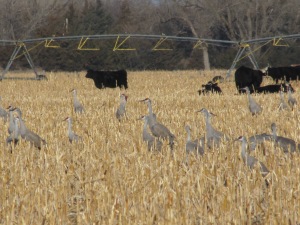It’s 6:00 a.m. on the North Platte River in Kearney, Nebraska. In the distance, on Interstate 80, the early morning hum of trucks traveling this highway that runs nearly 3000 miles, from San Francisco to New Jersey, can be heard .
 On the sandbars in front of us the sandhill cranes awaken, uttering their ancient call, and suddenly we are witnessing a migration that is more than 9 million years older, and for some of these birds a greater distance than the length of the highway.
On the sandbars in front of us the sandhill cranes awaken, uttering their ancient call, and suddenly we are witnessing a migration that is more than 9 million years older, and for some of these birds a greater distance than the length of the highway.
The North Platte River begins in the Never Summer Wilderness west of Fort Collins, Colorado and heads north to Casper, Wyoming where it turns abruptly south and east toward the Nebraska Sand Hills. The Cranes migration through Nebraska formerly spanned several hundred miles of the Platte River. Due to the diversion of water from the river, for urban and agricultural uses, the character of the river has changed. The annual floods from snow melt once scoured the river, removing vegetation and leaving large areas of open sand and gravel, providing the cranes ideal habitat.
Today the river is more sluggish and a forest has grown up along its length allowing species such as the cardinal to move into new territories but reducing suitable sites for cranes. This altered landscape has caused the migration in this central flyway, which includes over 80 percent of the worlds sandhill cranes, upwards of a half million birds, to be concentrated in a narrow area between the months late February and early April.
 The story of Kearney is not about wilderness, it’s a story about man and bird tolerating and in some ways benefiting from one another. In order to recover from the journey they have already made, traveling up to 500 miles in one day, and to prepare for the distance still to go, the birds must increase their body weight by 20 percent.
The story of Kearney is not about wilderness, it’s a story about man and bird tolerating and in some ways benefiting from one another. In order to recover from the journey they have already made, traveling up to 500 miles in one day, and to prepare for the distance still to go, the birds must increase their body weight by 20 percent.
While in the region the cranes feed primarily on corn gleaned from farms along the river low lands. The birds however pay their share in the form of ecotourism revenue. Visitors flocking to see the birds bring in over 10 million dollars to Kearney every year.
 In A Sand County Almanac, 1949, Aldo Leopold mourns the loss of America’s wetlands and predicts the demise of these magnificent birds “The last crane will trumpet his farewell and spiral skyward from the great marsh…and then a silence never to be broken, unless perchance in some far pasture of the Milky Way.
In A Sand County Almanac, 1949, Aldo Leopold mourns the loss of America’s wetlands and predicts the demise of these magnificent birds “The last crane will trumpet his farewell and spiral skyward from the great marsh…and then a silence never to be broken, unless perchance in some far pasture of the Milky Way.
Unlike the endangered whooping crane, the sandhill cranes population is healthy and thriving. The success of the cranes survival was not entirely without human intervention. In 1974, a bequest from Lillian Anette Rowe, a wildlife biologist, made possible the purchase of 782 acres including 2.5 miles of the river channel, wet meadows and some agricultural fields.
 Today the Rowe Sanctuary owned and managed by the National Audubon Society, has grown to nearly 1900 acres and offers dawn and dusk viewings of the birds from blinds along the river.
Today the Rowe Sanctuary owned and managed by the National Audubon Society, has grown to nearly 1900 acres and offers dawn and dusk viewings of the birds from blinds along the river.
